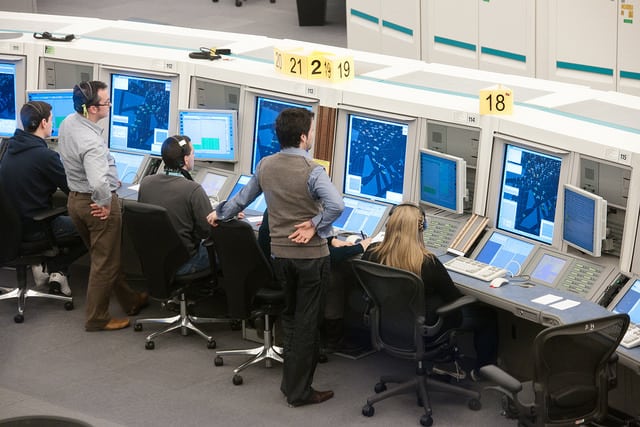[Avionics Today 12-15-2014] Flights are back in the air after a computer failure at National Air Traffic Services (NATS) Swanwick area control center grounded or delayed hundreds of flights across and beyond the U.K. on Friday. The Dec. 12 computer glitch, which NATS confirmed as a technical fault with the flight data system, disrupted airspace for hours and resulted in flight cancellations through the weekend.
 |
| Close up of Swanwick Centre Layout. Photo: NATS Press Office (flickr) |
“Swanwick controller workstations provide a number of tools and services to the controller to enable them to safely control a high volume of air traffic. In normal operations the number of workstations in use versus in standby fluctuates with the demands of the traffic being controlled,” a Saturday-afternoon statement from NATS explained. “In this instance a transition between the two states caused a failure in the system which has not been seen before. The failure meant that the controllers were unable to access all of the data regarding individual flight plans which significantly increases their workload.”
The system failure was buried by nearly 4 million lines of computer code, NATS Executive Chief Richard Deakin said in an interview with BBC. NATS technicians were able to get the system back up and running 45 minutes after the event. “The backup plans went into action as they should’ve done, so everything performed normally there. The skies were kept safe and unfortunately there was reduced capacity,” Deakin told BBC.
This latest disruption to airspace comes after a similar incident in December of last year in which the ground communications system in the Swanwick control operations room failed, disrupting airspace for a full day before returning to normal. As of this morning, the U.K. Civil Aviation Authority (CAA) and NATS have agreed to establish an investigation to determine the root causes of the incident, evaluate NATS’ response to the incident, asses ways to prevent or minimize further disruption to the national airspace infrastructure as well as how well the Air Navigation Service Provider (ANSP) has reacted to prior incidents, to put proper plans in place to preclude further similar events.
The urgent report will factor into the CAA’s review of NATS license, which has already begun and will “include an assessment of whether NATS is sufficiently incentivised [sic] to deliver the excellent levels of air traffic service that U.K. passengers have come to expect,” the CAA said in a statement.
Deakin noted that the systems at Swanwick are “fairly elderly,” and that the code that caused the glitch was written in the early 1990’s. He quickly followed that the ANSP is already looking to update the systems with a 5-year, $900 million investment to bring the systems up to date and in line with the Single European Skies program.
“In the next five years we’re going to be moving toward Internet-based systems, which are much more resilient than the systems we currently use,” Deakin said.